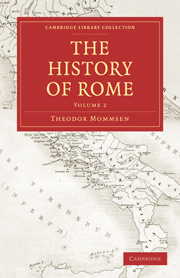Book contents
- Frontmatter
- Contents
- MAP OF ITALY
- BOOK THIRD: FROM THE UNION OF ITALY TO THE SUBJUGATION OF CARTHAGE AND OF THE GREEK STATES
- CHAPTER I CARTHAGE
- CHAPTER II THE WAR BETWEEN ROME AND CARTHAGE CONCERNING SICILY
- CHAPTER III THE EXTENSION OF ITALY TO ITS NATURAL BOUNDARIES
- CHAPTER IV HAMILCAR AND HANNIBAL
- CHAPTER V THE WAR UNDER HANNIBAL TO THE BATTLE OF CANNÆ
- CHAPTER VI THE WAR UNDER HANNIBAL FROM CANNÆ TO ZAMA
- CHAPTER VII THE WEST FROM THE PEACE OF HANNIBAL TO THE CLOSE OF THE THIRD PERIOD
- CHAPTER VIII THE EASTERN NATIONS AND THE SECOND MACEDONIAN WAR
- CHAPTER IX THE WAR WITH ANTIOCHUS OF ASIA
- CHAPTER X THE THIRD MACEDONIAN WAR
- CHAPTER XI THE GOVERNMENT AND THE GOVERNED
- CHAPTER XII THE MANAGEMENT OF LAND AND OF CAPITAL
- CHAPTER XIII FAITH AND MANNERS
- CHAPTER XIV LITERATURE AND ART
- CORRECTIONS
CHAPTER XII - THE MANAGEMENT OF LAND AND OF CAPITAL
Published online by Cambridge University Press: 05 October 2010
- Frontmatter
- Contents
- MAP OF ITALY
- BOOK THIRD: FROM THE UNION OF ITALY TO THE SUBJUGATION OF CARTHAGE AND OF THE GREEK STATES
- CHAPTER I CARTHAGE
- CHAPTER II THE WAR BETWEEN ROME AND CARTHAGE CONCERNING SICILY
- CHAPTER III THE EXTENSION OF ITALY TO ITS NATURAL BOUNDARIES
- CHAPTER IV HAMILCAR AND HANNIBAL
- CHAPTER V THE WAR UNDER HANNIBAL TO THE BATTLE OF CANNÆ
- CHAPTER VI THE WAR UNDER HANNIBAL FROM CANNÆ TO ZAMA
- CHAPTER VII THE WEST FROM THE PEACE OF HANNIBAL TO THE CLOSE OF THE THIRD PERIOD
- CHAPTER VIII THE EASTERN NATIONS AND THE SECOND MACEDONIAN WAR
- CHAPTER IX THE WAR WITH ANTIOCHUS OF ASIA
- CHAPTER X THE THIRD MACEDONIAN WAR
- CHAPTER XI THE GOVERNMENT AND THE GOVERNED
- CHAPTER XII THE MANAGEMENT OF LAND AND OF CAPITAL
- CHAPTER XIII FAITH AND MANNERS
- CHAPTER XIV LITERATURE AND ART
- CORRECTIONS
Summary
Roman economics
It is in the sixth century of the city that we first find economics, materials for a history of the times exhibiting in some measure the mutual connection of events; and it is in that century also that the economic condition of Rome emerges into view more clearly and distinctly. It was at this epoch that the wholesale system, as regards both the cultivation of land and the management of capital, became first established under the form, and on the scale, which afterwards prevailed; although we cannot exactly discriminate how much of that system is traceable to earlier precedent, how much to an imitation of the methods of husbandry and of speculation among peoples that were earlier civilized, especially the Phœnicians, and how much to the growth of capital and the growth of intelligence in the nation. A summary outline of these economic relations will conduce to a more accurate understanding of the internal history of Rome.
Roman husbandry applied itself either to the farming of estates, to the occupation of pasture lands, or to the tillage of petty holdings. A very distinct view of the first of these is presented to us in the description given by Cato.
Farming of estates. Their size
The Roman estates were, considered as larger holdings, uniformly of limited extent. That described by Cato had an area of 240 jugera; a very common measure was the so-called centuria of 200 jugera. Where the laborious culture of the vine was contemplated, the unit of husbandry was made still less; Cato assumes in that case an area of 100 jugera.
- Type
- Chapter
- Information
- The History of Rome , pp. 362 - 393Publisher: Cambridge University PressPrint publication year: 2010First published in: 1862



